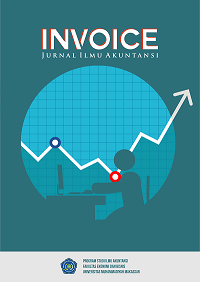Analysis of Detecting Potential Financial Statement Fraud in State-Owned Enterprises (SOEs) Using the Fraud Hexagon
DOI: https://doi.org/10.26618/inv.v6i2.15686
Abstract
This study aims to analyze the effect of elements in the Fraud Hexagon on financial statement fraud in state-owned enterprises (SOEs) listed on the Indonesia Stock Exchange (IDX) from 2018 to 2022. The dependent variable in this study is financial statement fraud, measured by the F-score Model. The independent variables are the six elements in the fraud hexagon: pressure, opportunity, rationalization, capability, arrogance, and collusion, each proxied by performance level, monitoring ineffectiveness, change of auditors, change of director, CEO duality, and audit fees. This study utilizes 105 sample data selected using the purposive sampling method. The data was analyzed using multiple linear regression analysis. The results indicate that pressure (performance level) has a positive and significant effect on financial statement fraud. Capability (change of director) has a negative and significant effect, suggesting that changes in leadership can mitigate fraud risks. However, opportunity (monitoring ineffectiveness), rationalization (change of auditors), arrogance (CEO duality), and collusion (audit fees) do not significantly influence the potential for financial statement fraud. These findings highlight the importance of monitoring performance levels and leadership changes in preventing financial statement fraud in SOEs. The study provides valuable insights for regulators and corporate governance bodies to enhance their fraud prevention frameworks and ensure the integrity of financial reporting. This research contributes to the existing literature by integrating the Fraud Hexagon model in the context of SOEs, offering a comprehensive understanding of the factors influencing financial statement fraud in a developing country.References
Achmad, T., Ghozali , I., & Pamungkas, ID (2022). Hexagon fraud: Detection of fraudulent financial reporting in Indonesian state-owned enterprises. Economies , 10 (1), 13.
Aghghaleh , SF, Mohamed, ZM, & Rahmat, MM (2016). Detecting Financial Statement Frauds in Malaysia: Comparing the Abilities of Beneish and Dechow Models. Asian Journal of Accounting & Governance , 7 .
Association of Certified Fraud Examiners (ACFE) Indonesia. (2020). 2019 Indonesian Fraud Survey . Indonesia Chapter #111 53.
Aviantara , R. (2021). The association between fraud hexagon and government's fraudulent financial report. Asia Pacific Fraud Journal , 6 (1), 26–42.
Dechow, P. M., Ge, W., Larson, C. R., & Sloan, R. G. (2011). Predicting material accounting misstatements. Contemporary Accounting Research , 28 (1), 17–82.
Ghozali , I. (2021). Multivariate Analysis Applications with the IBM SPSS 26 Program (10th ed.). Diponegoro University Publishing Agency.
Hadi, MSW, Kirana, DJ, & Wijayanti, A. (2021). Detection of Fraudulent Financial Reporting Using Fraud Hexagon in Companies in Indonesia. Proceedings of BIEMA (Business Management, Economic, and Accounting National Seminar) , 2 , 1036–1052.
Hendrastuti, R., & Harahap, R.F. (2023). Agency theory: Review of the theory and current research. Journal of Actual Accounting , 10 (1), 85.
Hidayah, E., & Saptarini , GD (2019). Pentagon fraud analysis in detecting potential financial statement fraud of banking companies in Indonesia. Uii-Icabe Proceedings , 89–102.
Imtikhani , L., & Sukirman, S. (2021). Determinants of Fraudulent Financial Statements through the Perspective of Fraud Hexagon Theory in Mining Companies. Journal of Business Accounting , 19 (1), 96–113.
Inawati , WA, & Arief, MAB (2022). The Influence of Fraud Hexagon Perspective on Fraud Financial Statements. Proceedings of the 3rd Asia Pacific International Conference on Industrial Engineering and Operations Management, Johor Bahru, Malaysia .
Jensen, M. C., & Meckling, W. H. (1976). Theory of the Firm: Managerial Behavior, Agency Cost and Ownership Structure. Journal of Financial Economics , 305–360. https://doi.org/10.1177/0018726718812602
Lestari, AA, & Widiyati , D. (2023). Effect of Financial Target, Ineffective Monitoring, and Whistleblowing Systems on Fraudulent Financial Reporting. Journal of Industrial Engineering & Management Research , 4 (2), 102–110.
Lionardi , M., & Suhartono , S. (2022). Detection of the Possible Occurrence of Fraudulent Financial Statements using the Fraud Hexagon. Monetary-Journal of Accounting and Finance , 9 (1), 29–38.
Nadziliyah, H., & Primasari, NS (2022). Hexagon Fraud Analysis of Financial Statement Fraud in Infrastructure, Utility and Transportation Sector Companies. Accounting and Finance Studies , 2 (1), 21–39.
Pratiya , MAM, Susetyo , B., & Mubarok , A. (2018). The influence of financial stability, performance level financial targets, asset turnover ratio, audit committee financial expertise, and profitability on fraudulent financial statements. Permana: Journal of Taxation, Management and Accounting , 10 (1).
Ratnasari, E., & Solikhah , B. (2019). Analysis of Financial Statement Fraud: Pentagon Theory Fraud Approach. Gorontalo Accounting Journal , 2 (2), 98–112.
Sari, SP, & Nugroho, NK (2021). Financial Statements Fraud with the Vousinas Fraud Hexagon Model Approach: An Overview of Public Companies in Indonesia. Annual Conference of Ihtifaz : Islamic Economics, Finance, and Banking , 409–430.
Sasongko , N., & Wijayantika , SF (2019). Fraud Risk Factors for the Implementation of Fraudulent Financial Reporting (Based on the Crown's Fraud Pentagon Theory Approach). Indonesian Accounting and Finance Research , 4 (1), 67–76.
Septiningrum , KE, & Mutmainah , S. (2022). Analysis of Factors that Influence the Occurrence of Financial Statement Fraud: Fraud Hexagon Theory Perspective (Empirical Study of Banking Sector Companies Listed on the Indonesian Stock Exchange for the 2018–2020 Period). Diponegoro Journal of Accounting , 11 (4).
Septriani , Y., & Handayani , D. (2018). Detecting fraudulent financial statements with pentagon fraud analysis. Journal of Financial and Business Accounting , 11 (1), 11–23.
Sumbari, S., Kamaliah, K., & Fitrios, R. (2023). Analysis of the Hexagon Fraud Model in Detecting Potential Financial Report Fraud in State-Owned Companies. CURRENT: Journal of Current Accounting and Business Studies , 4 (1), 179–196.
Suri, AG, & Rahman, A. (2023). Hexagon Fraud Analysis in Detecting Potential Fraud in Financial Reports in State-Owned Enterprises (BUMN). Literate Syntax; Indonesian Scientific Journal , 8 (5), 3495–3515.
Triyuwono , E. (2018). Contracting process, agency theory and corporate governance (contracting process, agency theory, and corporate governance). Available at SSRN 3250329 .
Tuanakotta, T.M. (2013). Detecting Financial Report Manipulation . Salemba Empat Publishers .
Vousinas , G.L. (2019). Advancing theory of fraud: the SCORE model. Journal of Financial Crime , 26 (1), 372–381.
Wicaksono, A., & Suryandari , D. (2021). The Analysis of Fraudulent Financial Reports Through Fraud Hexagon on Public Mining Companies. Accounting Analysis Journal , 10 (3), 220–228.
Yadiati , W., & Rezwiandhari , A. (2023). Detecting Fraudulent Financial Reporting in State-Owned Companies: Hexagon Theory Approach. JAK (Accounting Journal) Scientific Studies in Accounting , 10 (1), 128–147.
Downloads
Published
Issue
Section
License
Authors who publish with Invoice: Jurnal Ilmu Akuntansi agree to the following terms:
-
Copyright Ownership
The copyright of all articles published in this journal remains with the author(s). However, the authors grant Invoice: Jurnal Ilmu Akuntansi the right of first publication with the work simultaneously licensed under a Creative Commons Attribution 4.0 International License (CC BY 4.0). This license allows others to share, copy, redistribute, adapt, and build upon the work for any purpose, even commercially, as long as proper credit is given to the original author(s) and the source. -
Licensing and Access
Invoice: Jurnal Ilmu Akuntansi provides immediate open access to its content on the principle that making research freely available to the public supports a greater global exchange of knowledge. All published materials are available freely without subscription or payment and can be accessed, downloaded, and reused by any user provided that appropriate attribution is given. -
Permission for Reuse
For uses not covered by the CC BY 4.0 license, such as commercial reprints, translations, or any form of adaptation without clear attribution, users must obtain written permission from the editorial team. Requests for such permissions can be directed to the editorial office at: [invoice@unismuh.ac.id]. -
Plagiarism and Originality
Authors are responsible for the originality of their submissions. All articles are screened for plagiarism using appropriate tools before acceptance. Manuscripts found to contain unoriginal content or infringing materials will be rejected or retracted as per journal policy.














